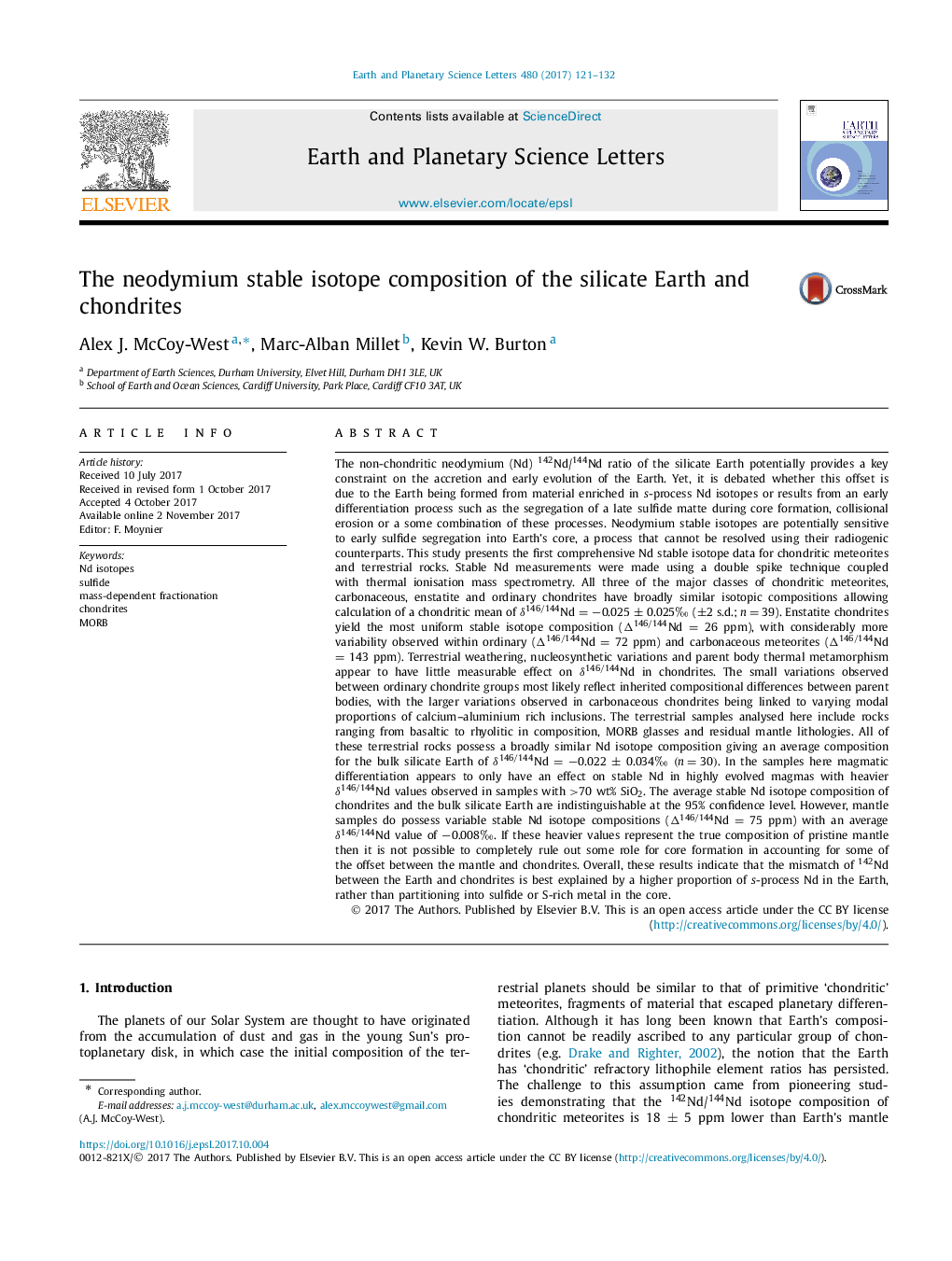| کد مقاله | کد نشریه | سال انتشار | مقاله انگلیسی | نسخه تمام متن |
|---|---|---|---|---|
| 8907396 | 1634676 | 2017 | 12 صفحه PDF | دانلود رایگان |
عنوان انگلیسی مقاله ISI
The neodymium stable isotope composition of the silicate Earth and chondrites
ترجمه فارسی عنوان
ترکیب ایزوتوپ پایدار نئودیمیوم سیلیکاتیک زمین و کندریت
دانلود مقاله + سفارش ترجمه
دانلود مقاله ISI انگلیسی
رایگان برای ایرانیان
کلمات کلیدی
موضوعات مرتبط
مهندسی و علوم پایه
علوم زمین و سیارات
علوم زمین و سیاره ای (عمومی)
چکیده انگلیسی
The non-chondritic neodymium (Nd) 142Nd/144Nd ratio of the silicate Earth potentially provides a key constraint on the accretion and early evolution of the Earth. Yet, it is debated whether this offset is due to the Earth being formed from material enriched in s-process Nd isotopes or results from an early differentiation process such as the segregation of a late sulfide matte during core formation, collisional erosion or a some combination of these processes. Neodymium stable isotopes are potentially sensitive to early sulfide segregation into Earth's core, a process that cannot be resolved using their radiogenic counterparts. This study presents the first comprehensive Nd stable isotope data for chondritic meteorites and terrestrial rocks. Stable Nd measurements were made using a double spike technique coupled with thermal ionisation mass spectrometry. All three of the major classes of chondritic meteorites, carbonaceous, enstatite and ordinary chondrites have broadly similar isotopic compositions allowing calculation of a chondritic mean of δ146/144Nd = â0.025 ± 0.025â° (±2 s.d.; n=39). Enstatite chondrites yield the most uniform stable isotope composition (Î146/144Nd = 26 ppm), with considerably more variability observed within ordinary (Î146/144Nd = 72 ppm) and carbonaceous meteorites (Î146/144Nd = 143 ppm). Terrestrial weathering, nucleosynthetic variations and parent body thermal metamorphism appear to have little measurable effect on δ146/144Nd in chondrites. The small variations observed between ordinary chondrite groups most likely reflect inherited compositional differences between parent bodies, with the larger variations observed in carbonaceous chondrites being linked to varying modal proportions of calcium-aluminium rich inclusions. The terrestrial samples analysed here include rocks ranging from basaltic to rhyolitic in composition, MORB glasses and residual mantle lithologies. All of these terrestrial rocks possess a broadly similar Nd isotope composition giving an average composition for the bulk silicate Earth of δ146/144Nd = â0.022 ± 0.034â° (n=30). In the samples here magmatic differentiation appears to only have an effect on stable Nd in highly evolved magmas with heavier δ146/144Nd values observed in samples with >70 wt% SiO2. The average stable Nd isotope composition of chondrites and the bulk silicate Earth are indistinguishable at the 95% confidence level. However, mantle samples do possess variable stable Nd isotope compositions (Î146/144Nd = 75 ppm) with an average δ146/144Nd value of â0.008â°. If these heavier values represent the true composition of pristine mantle then it is not possible to completely rule out some role for core formation in accounting for some of the offset between the mantle and chondrites. Overall, these results indicate that the mismatch of 142Nd between the Earth and chondrites is best explained by a higher proportion of s-process Nd in the Earth, rather than partitioning into sulfide or S-rich metal in the core.
ناشر
Database: Elsevier - ScienceDirect (ساینس دایرکت)
Journal: Earth and Planetary Science Letters - Volume 480, 5 December 2017, Pages 121-132
Journal: Earth and Planetary Science Letters - Volume 480, 5 December 2017, Pages 121-132
نویسندگان
Alex J. McCoy-West, Marc-Alban Millet, Kevin W. Burton,
